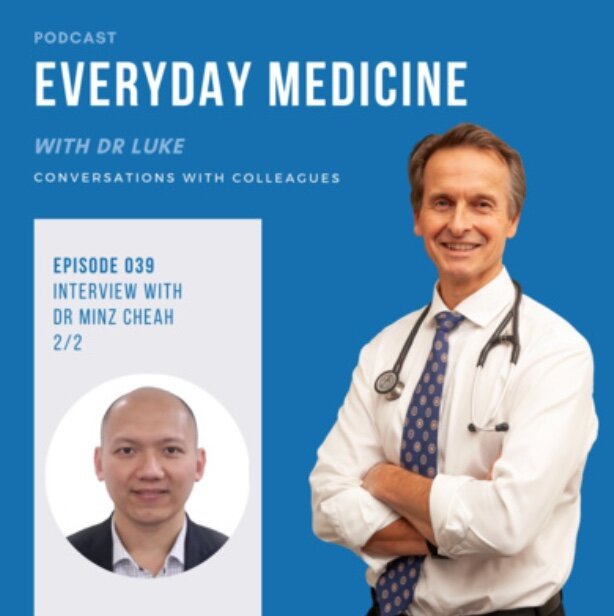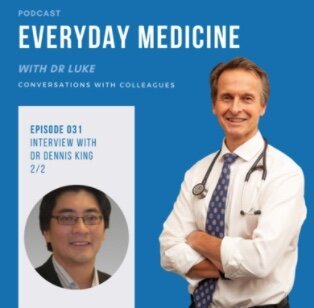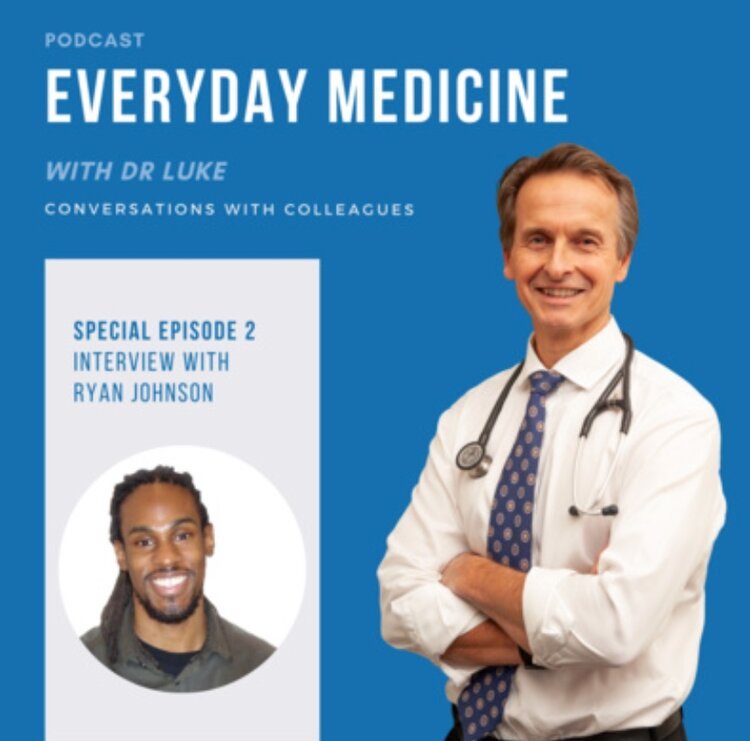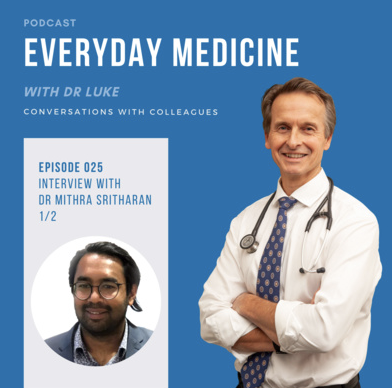Everyday Medicine by Dr Luke Crantock
Conversations with colleagues providing helpful ideas and advice in healthcare
Episode 41. Secondary Prevention of Cardiovascular Disease with Dr John Counsell (Part 2)
Heart disease affects one in six Australians with an AMI occurring every 10 minutes and accounts for one in four of all deaths, so primary and secondary prevention are very important considerations in relation to any patient presenting with heart disease or at risk of heart disease. Risk factors including family history, lipid abnormalities, diabetes mellitus, hypertension, smoking or those with elevated BMI all need consideration. Whilst there have been significant controversies regarding lipids management and the use of statins, the evidence for their use, particularly in secondary prevention of heart disease is clear.
Episode 41. Primary Prevention of Cardiovascular Disease with Dr John Counsell [Part 1]
Heart disease affects one in six Australians with an AMI occurring every 10 minutes and accounts for one in four of all deaths, so primary and secondary prevention are very important considerations in relation to any patient presenting with heart disease or at risk of heart disease. Risk factors including family history, lipid abnormalities, diabetes mellitus, hypertension, smoking or those with elevated BMI all need consideration. Whilst there have been significant controversies regarding lipids management and the use of statins, the evidence for their use, particularly in secondary prevention of heart disease is clear.
Episode 40. Mole mapping and skin cancer surveillance with Dr Archie Xu
Non-melanotic skin cancers and melanoma are the most common cancers affecting humans. At least two in three Australians will be diagnosed with skin cancer before the age of 70 years and the risk is higher for men than women. Whilst basal cell carcinomas and squamous cell carcinomas are more common they are not as lethal as melanomas which are referred to as Australia’s “national cancer”. Indeed in 2020 it is estimated that 16,200 will be diagnosed with melanoma, that is one new case every half hour and a death every five hours.
Episode 39. Muscle Joints Aches and Pains with Dr Minz Cheah
Based on the Australian Bureau of Statistics National Health Survey data about one in three people over the age of 18 living in Australia have hypertension or were taking blood pressure lowering medications. A staggering number requiring therapy for a condition which impacts on cerebrovascular disease, coronary artery disease, chronic kidney disease, heart failure and mortality.
Episode 38. Hypertension with Dr Minz Che
Based on the Australian Bureau of Statistics National Health Survey data about one in three people over the age of 18 living in Australia have hypertension or were taking blood pressure lowering medications. A staggering number requiring therapy for a condition which impacts on cerebrovascular disease, coronary artery disease, chronic kidney disease, heart failure and mortality.
Episode 37. Why We Get Fat And What We Can Do About It with Professor Joseph Proietto
The western world faces a very significant obesity epidemic. In Australia, two-thirds of our population or 12.5 million are either overweight or obese and as a consequence may experience many medical sequelae including development of the metabolic syndrome, type 2 diabetes, cardiovascular disease, cerebrovascular disease, osteoarthritis and depression, contributing significantly to our health burden. In the first part of this series, we were joined by Joseph Proietto, Professor Emeritus at the University of Melbourne, the Department of Medicine at Austin Health and an endocrinologist specialising in diabetes and obesity to discuss why we become obese. Professor Proietto joins us again to guide us through a strategy of how to treat and manage obesity and direct our patients toward a healthy body mass index (BMI).
Episode 36. Why We Get Fat with Professor Joseph Proietto
Up to two thirds of Australians are either overweight or obese as defined by body mass index (overweight: BMI 25-29.9, obese: BMI >30) with subsequent significant medical consequences including cardiovascular disease, type 2 diabetes, cerebrovascular disease (metabolic syndrome), osteoarthritis and depression. Becoming overweight and obese involves complex interactions between neurohormonal systems of the gut, neurobiology of the brain (particularly the hypothalamus) and leptin production from adipose sites coupled with an environment where there is an abundance of high glycaemic energy dense foods. Science demonstrates that the overarching controls of obesity are genetic (70%) rather than environmental (30%). Adoption studies relating to monozygotic twins demonstrate this. In view of the metabolic consequences of obesity, understanding why we get fat is extremely important to medical practitioners.
Episode 35. The spleen and postsplenectomy syndrome with Dr Mohammed Al Souffi
The spleen performs a large number of important functions including processing and removal of opsonized pathogens, cellular maintenance, immunoglobulin production and the removal of effete worn out red blood cell. When removed either through trauma or for therapeutic indications the risk of overwhelming post splenectomy infection (OPSI) increases significantly; up to 58 times the general population in the setting of trauma and up to 1,100 times increased risk when for thalassaemia.
Episode 34. Atherosclerosis with Dr James Sapontis
Coronary artery disease caused by atherosclerosis is responsible for one heart attack every ten minutes in Australia. Not all plaques however are equally dangerous or vulnerable, and stable plaques may be asymptomatic and associated with low risk of coronary events contrasted with the unstable or ruptured plaque. To discuss this very interesting subject in more detail we are joined by Dr James Sapontis, experienced cardiologist and head of complex coronary intervention at Monash Heart who will consider:
Episode 33. New Advances in Cardiology with Dr James Sapontis
We are joined today by Dr James Sapontis, head of complex coronary intervention at Monash Heart and formerly trained through Mahi Missouri and Kings College London to discuss new advances in the field of cardiology.
Episode 32. Lung Cancer with Mr Cliff Choong
Lung cancer is a major problem facing Australian doctors representing 9% of all cancer diagnoses and with 12,200 new cases of lung cancer diagnosed each year it is the fifth most commonly diagnosed cancer, but the most common cause of cancer death in this country for both men and for women. The early presentation of lung cancer may be as subtle as a small coin lesion or nodule seen on chest imaging and there are a multitude of ways in which such nodules may be interrogated further. Whilst a wait and watch approach may be appropriate, further evaluation by VATS with a tissue diagnosis maybe required.
Episode 31. Benign Prostatic Hyperplasia with Dr Dennis King
Benign prostatic hyperplasia (BPH) is a common condition as men age and the most common benign tumour in men. Approximately half of all men between the age of 51 and 60 years have BPH and upto 90% of men over the age of 80 years have it. Prostate enlargement can be responsible for a variety of urinary symptoms including hesitancy with poor urinary flow, frequency, nocturia and incontinence. Where surgery was once a likely outcome for this condition many medical therapies have evolved to provide suitable alternatives including Alpha 1 adrenoceptor blockers resulting in smooth muscle relaxation in the prostate and bladder neck, 5-alpha reductase inhibitors which reduce prostate volume and growth by inhibiting the conversion of testosterone to dihydrotestosterone (DITT) and phosphodiesterase 5 inhibitors which may improve quality of life and voiding symptoms.
Special Episode 2. The Way to Walk with Ryan Johnson
In this podcast episode, we have a conversation with physiotherapist Ryan Johnson of R3 Physiotherapy in London who is passionate about gait correction and has written a book called The Way to Walk.
Episode 30. Controversies in Prostate Cancer with Dr Dennis King
Prostate cancer is the second most commonly diagnosed cancer among men and the second most common cause of death from cancer in men, yet many prostate cancers are not fatal and some autopsy series have demonstrated up to 50% or more silent prostate cancers in men over the age of 70 years.
Episode 29. Personalised Medicine with Dr Sem Liew
Personalised medicine also known as precision medicine uses the knowledge of genetics to help predict disease development and to influence decisions about lifestyle choices and to tailor treatment to a particular individual's tumour. The hope is that personalised medicine will allow more appropriate choices of targeted therapy and minimise side effects rather than choosing a "one size fits all" approach to prescription medication.
Episode 28. Immunotherapy with Dr Sem Liew
Cancer is responsible for over 40,000 deaths annually in Australia and has traditionally been managed by modalities including surgery, radiotherapy and chemotherapy. In 1992, Tasuku Honjo's discovery of checkpoint proteins on tumour cells led to the birth of immunotherapy which has revolutionised the treatment of many cancers including bladder and kidney cancer, head and neck cancer, melanoma, non-small cell lung cancer and Hodgkin's lymphoma.
Episode 27. Robotic Knee Surgery with Mr Andrew Tang
In this podcast episode we have a conversation with Mr Andrew Tang, Director of the Epworth Musculoskeletal Clinical Institute and an experienced orthopaedic surgeon operating at Epworth Richmond and St John of God Berwick since the early 1990's.
Episode 26. Pancreatic Cysts with Dr Mithra Sritharan
As clinicians we are often faced with the dilemma of working up cystic structures in the pancreas. These may have been discovered incidentally but may also be clinically relevant and contributing to symptoms. In this podcast episode we are joined by Mithra Sritharan a hepatopancreaticobiliary and general surgeon with a particular interest in liver and pancreatic disease, but whose management skills and high level of competence is evident from this interview.
Episode 25. SOL's Liver with Dr Mithra Sritharan
Our approach to space-occupying lesions (SOL's) in the liver is dependent on a firm knowledge of the potential pathology, the choice of imaging modality and the understanding of any background clinical liver disease in the index patient.
Episode 24. Palliative Care with Dr Sally McDonald
In this episode, we talk with experienced general practitioner Dr Sally McDonald who has committed a large part of her time, energy and emotion providing palliative care for her local community.


![Episode 41. Primary Prevention of Cardiovascular Disease with Dr John Counsell [Part 1]](https://images.squarespace-cdn.com/content/v1/6246708462f6e814e578b7a3/1653455742358-BI3NZ2T49PTYKWSG4CCH/Dr%2BLuke%2BCrantock%2BEveryday%2BMedicine%2Bwith%2BDr%2BJohn%2BCounsell.jpeg)

















